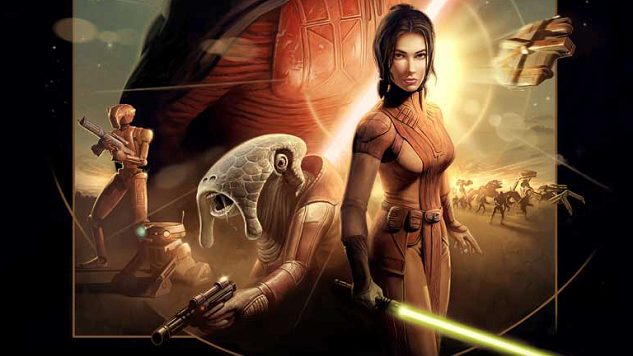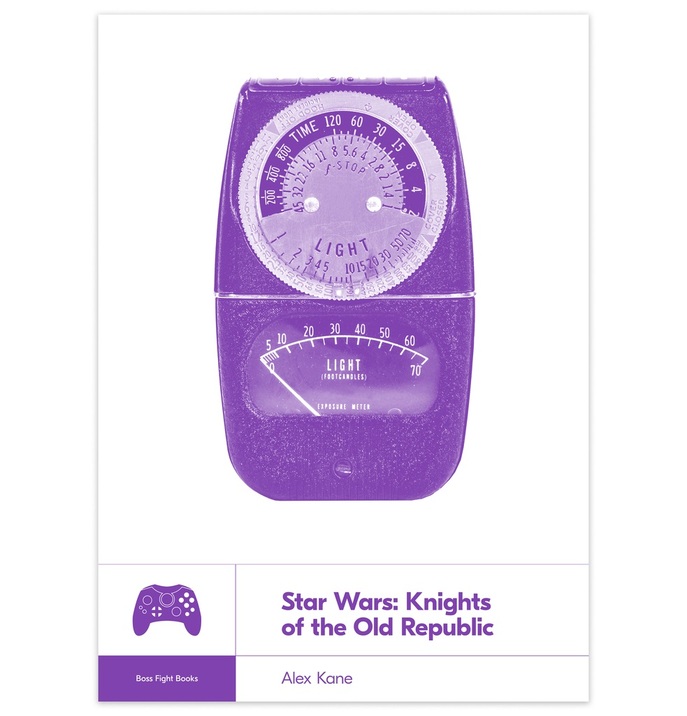Boss Fight Books’ Knights of the Old Republic Studies a Studio on the Verge of a Golden Age
Games Reviews Knights of the Old Republic
Alex Kane’s new book on Knights of the Old Republic is something special. In the past, I could roughly group everything that came out of publisher Boss Fight Books in one of two categories: generally, they are either about how a game made the author feel or they are about how a game was made. Derek Yu’s book on his own Spelunky or Anna Anthropy’s historical deep-dive on ZZT are top of the line in the latter category, and I think that we can safely add Kane’s interview-heavy, short volume on Knights of the Old Republic to that mix. It is, in a word, good.
That quality of being good mostly emanates from two places. The first is that Knights of the Old Republic is a game that made a huge splash at a very particular moment in time. It’s a Star Wars title, it was the beginning of a run of games that allowed developer BioWare to dominate the games industry for a short time, and it’s actually worthwhile to play. Unlike some other Boss Fight Books that dig into a game for its value as an oddity or outlier, Kane is delivering a smooth, informative deep-dive into how something precious to many people got made. From that starting position, the book is already in a great place.
Crucially, Kane also makes the choice to stay away from close-reading specific characters, plot points, or fan-favorite moments. This is a book that paints a picture of how something came into being, not what that something means in a broad sense, and that means that Kane can allow his interviewees to carry most of the book.
From various members of the team, we learn how BioWare came to an agreement with LucasArts, how the Neverwinter Nights engine was repurposed for Star Wars goals, and how they fought to cram so many lightsaber colors into Knights of the Old Republic. There’s also extensive information about crunching for 12 or 16 hour days across the development cycle for the game, and an amusing anecdote about how Ed Asner ended up as a voice actor for the project.
What I found particularly fascinating was how Kane paints a portrait of lead designer James Ohlen’s contributions to the project. When Ohlen is in the spotlight in the book, you can see the shape of the ascendant BioWare of the mid-2000s as well as the BioWare of our current moment. In talking about developing the plot of Knights of the Old Republic, Ohlen explains what setting Knights 4,000 years before the Star Wars prequels allowed the team to do narratively: “[T]he kind of stories that we like to tell at BioWare are epic in scope, where the player is the hero who’s defeating the big bad—the evil that’s threatening the land or the universe or the galaxy. And if it were an Attack of the Clones tie-in, the players would not be the heroes of the galaxy. That would be Anakin Skywalker and Obi-Wan Kenobi.” Later, we find out that Ohlen helped populate the game with some of his Dungeons & Dragons characters from his youth. And, in another anecdote, Ohlen says that the job of a creative lead “is creating a fantasy fulfillment—especially if you’re working with an intellectual property—for fans of that IP.”
None of this is wrong, and it all makes sense in the muck of game design, but it provides the outline of a development process that needs big stakes, broad strokes, and a reliance on what came before to make the final product work. And whether you like it or not, it seems that the focus of prestige single-player experiences has moved away from these big generic stakes and into tighter, more conceptually grounded work. A team cannot make a God of War or a Sekiro out of big, broad strokes. The work of the prestige game in 2019 and beyond seems to involve a lot of fine brushwork.
While Kane certainly isn’t making any arguments about the development of Knights and the health of BioWare today, it’s hard to read his extensive account of the real boom moment that was the development of that game and not extrapolate into the now. That’s part of the greatness of the book; it provides enough information that you can mentally evaluate what led to the creation of that game and what leads to the creation of current games from the same studio, despite studio staff and leadership radically changing between then and now.
The flip side of the informative, interview-heavy approach, however, is that the book has very little room for negativity. We don’t see much criticism of the project from the interviewed subjects, and Kane himself seems unwilling to do much other than pile praise on the well-regarded game. There is a moment, though, where artist John Gallagher explains that he absolutely hated, and presumably still hates, the design of Darth Malak: “It doesn’t bother me. It doesn’t insult me. I just don’t think it’s a very well-realized design.” I wish there was a little more of that across the book.
If you enjoy Knights of the Old Republic, then you should read Alex Kane’s book on it. If you like stories about how games are made, this is a well-written one of those. This would make a great gift for any Star Wars nerd, and I’m looking forward to the next book from Kane.
